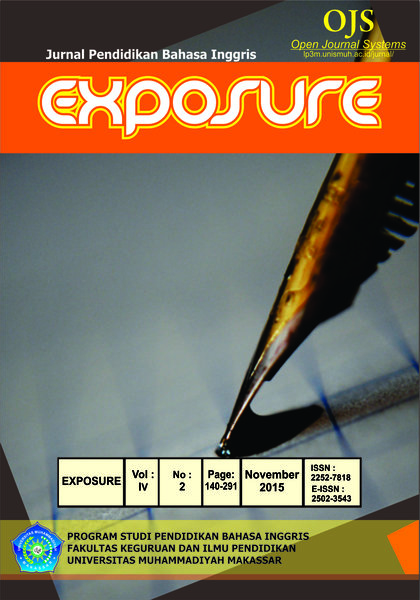WEBBING TECHNIQUE TO IMPROVE THE STUDENTS´ WRITING RECOUNT
DOI:
https://doi.org/10.26618/exposure.v4i2.924Abstract
This research was aimed at investigating the use of webbing technique in teaching writing recount text. A quasi experimental design was employed with two classes of the eleventh graders at one school in Sungguminasa, Gowa selected with cluster sampling as sample. The data were obtained through a pre-test, a post-test and an questionnaire. The writing assessment was covering content, schematic structure, and language use. The findings were analyzed statistically using independent t-test procedure. The statistical computation showed that webbing technique was likely effective in improving the students’ writing skill in recount text (value of t 6,74>value of t table1,99). Furthermore, the students´ perception towards webbing technique is 91,7% students agree that this technique could help them to increase their writing skill. Designing the learning purpose appropriately which considers students’ needs and language level may ease teachers to use the webbing technique in improving students’ writing recount text. The teachers may try to take advantage of webbing technique to be utilized in their classroom activities to conduct an effective and interesting learning atmosphere in the classroom.
References
Anderson, M & Anderson, K. 1997.Text Type in English 2. Malaysia: Mac Millan.
Bruce, F. 1986. Why We Write. A Thematic Reader.
Buzan (2005) Mind Mapping (Retrieved on July 15, 2012, at www.buzan.com)
Christie, F &Maton K. 2011.Disciplinarity: Function Linguistic and Sociological Perspective. New York: Continuum International Publisher.
Campbell. 1972. Teaching English as Second Language. New York: Mc. Graw Hill
Derewinka B. 2004. Exploring How Texts Work. Sydney: Primarily English Teaching Association.
Emilia, E. 2008.MenulisTesisdanDisertasi. Bandung: Rizqi Press.
Emilia, E. 2011.Teaching Writing Developing Critical Learners. Bandung: Rizqi Press.
Feez, S. 1998. Writing Skills. Phoenix: Phoenix Education.
Gerot, L &Nignall, P. 1994. Making Sense of Functional Grammar. Australia: Antipodean Education Enterprise (AEE)
Gibbon, Paulina. 2002. Scaffolding Language Scaffolding Learning (Teaching Second Language Learners in the Mainstream Classroom). United Stated of America: Heinemann
Gay, L,R. (1998). Educational Research. Competencies for Analysis and Application. Ohio: Charles E. Merril Pblishing Co
Hatch, E & Farhady, H. 1982.Research Design and Statistic for Applied Linguistic. London: Newbury House Publisher, Inc.
Idoll (2000) Skill Focus: Connecting Ideas and Inferring Meaning (Retrieved on July, 17 2012 at
www.ehow.com/list_7697668_webbingstrategies.html)
Johns, R.T (2000) Cooperative Learning (Retrieved on July 13, 2012, Available at www.staff.unimainz.de/kesslet/arbeit/kriss/cooperativelearning/jhons)
Kranzler, G &Moursund, j. 1999. Statistic for the Terrified. New Jersey:
Prentig Hall, Inc.
Lin, B. 2006. Genre-Based Teaching and Vygotskian Principle in EFL: the Case of University Writing Course. Asian EFL Journal; English Language Teaching and Research Articles, Vol 8 (30)
Manda, Gilbert (2011) Webbing Strategies (Meaning (Retrieved on July, 17 2012 at www.schools.nsw.edu.au/learning/7-12assesments/teachingstrategies)
Macken, Horarik M. 2002. “Something to Shoot for”: A Systematic Functional Approach to Teaching Genre in Secondary School Science. NJ: Lawrence Eribaum Associates.
Mande, Gilbert (2011) Webbing Strategies (Retrieved on July 15, 2012,
Available at www.ehow.com.
Paltridge, B. 2004.Approaches to Teaching Second Language Writing. Paper Presented at 17th English Australia Conference, Adelaide, South Australia.
Patel, M.F & Jain, P.M. 2008.English Language Teaching. Jaipur: Sunrise Publisher.
Peterson, A (2003) 30 Ideas for Teaching Writing-National Writing Project (Retrieved on July 11 available at www.nwp.rg/cs/public/print/resource/922
Romanov, N (2011) what is Perception? (http://Journal. Crosit.Com/2011/06/rumanovperception.tpl)
Trochim, W.M.K (2006) Research Methods Knowledge Base: Nonprobability Sampling. (Retrieved on July 12, 2012. Available at www.nwp.rg/cs/public/print/resource/922)
Walliman, N. 2006.Social Research Methods. London: Sage Publication. ltd
Yan, Guo. 2005. A Process Genre Model for Teaching Writing. UK: English Teaching Forum.
Downloads
Published
Issue
Section
License
Authors who publish with this journal agree to the following terms:
In order to assure the highest standards for published articles, a peer review policy is applied. In pursue of the compliance with academic standards, all parties involved in the publishing process (the authors, the editors and the editorial board and the reviewers) agree to meet the responsibilities stated below in accordance to the Journal publication ethics and malpractice statement.
Duties of Authors:
- The author(s) warrant that the submitted article is an original work, which has not been previously published, and that they have obtained an agreement from any co-author(s) prior to the manuscript’s submission;
- The author(s) should not submit articles describing essentially the same research to more than one journal;
- The authors(s) make certain that the manuscript meets the terms of the Manuscript Submission Guideline regarding appropriate academic citation and that no copyright infringement occurs;
- The authors(s) should inform the editors about any conflict of interests and report any errors they subsequently, discover in their manuscript.
Duties of Editors and the Editorial Board:
- The editors, together with the editorial board, are responsible for deciding upon the publication or rejection of the submitted manuscripts based only on their originality, significance, and relevance to the domains of the journal;
- The editors evaluate the manuscripts compliance with academic criteria, the domains of the journal and the guidelines;
- The editors must at all times respect the confidentiality of any information pertaining to the submitted manuscripts;
- The editors assign the review of each manuscript to two reviewers chosen according to their domains of expertise. The editors must take into account any conflict of interest reported by the authors and the reviewers.
- The editors must ensure that the comments and recommendations of the reviewers are sent to the author(s) in due time and that the manuscripts are returned to the editors, who take the final decision to publish them or not.
Authors are permitted and encouraged to post online a pre-publication manuscript (but not the Publisher’s final formatted PDF version of the Work) in institutional repositories or on their Websites prior to and during the submission process, as it can lead to productive exchanges, as well as earlier and greater citation of published work (see The Effect of Open Access). Any such posting made before acceptance and publication of the Work shall be updated upon publication to include a reference to the Publisher-assigned DOI (Digital Object Identifier) and a link to the online abstract for the final published Work in the Journal.




